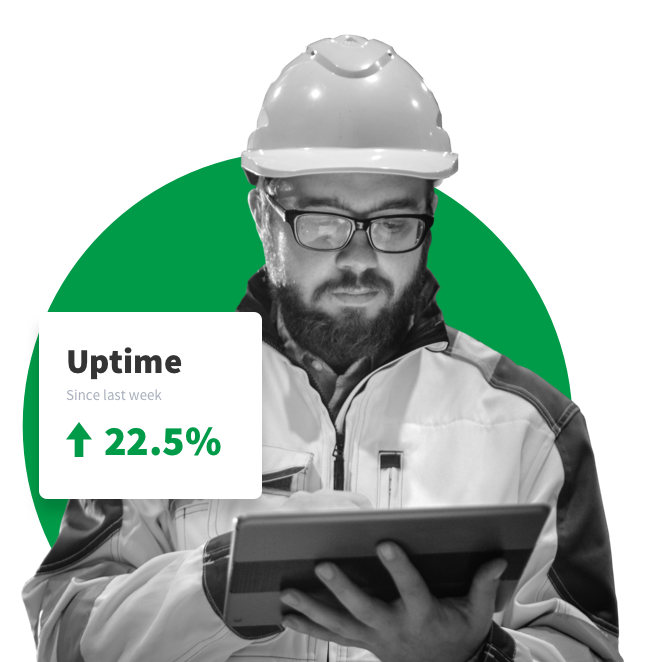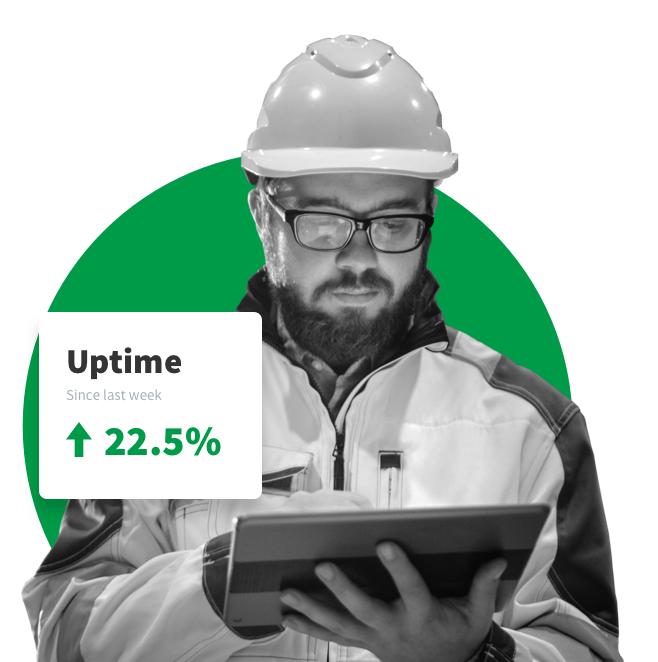
What Is CMMS Software?
Uses, Prices, & Benefits
All manufacturing plants need CMMS software. Machines break. CMMS software helps managers both prevent breakdowns from happening and respond to them when they do happen. It does this by creating a central hub for all data about machines on the manufacturing plant floor.

Ready to Get Started? Request a Free Consultation.
A computerized maintenance management system, or CMMS, is a digital software platform and database used to centralize and manage operational assets, like maintenance data, in a manufacturing plant. CMMS software mostly relates to a facility’s production equipment and the maintenance tasks required to care for that equipment. It's designed to automate day-to-day maintenance workflows that prevent machine breakdowns and help plant personnel address breakdowns with speed and efficiency.
CMMS software tracks preventive maintenance, which is like getting the oil in your car changed; it's scheduled based on intervals of time. While a CMMS focuses on day-to-day maintenance execution, enterprise asset management (EAM) systems manage an asset’s entire lifecycle. Think of CMMS as the hands-on toolkit inside the broader EAM toolbox.
The purpose of CMMS software is to reduce machine downtime. When a machine breaks down, it impacts production and, ultimately, a manufacturing plant's bottom line. CMMS provides maintenance teams with the information they need to plan effectively and make better decisions on the plant floor.
CMMS is used to plan, schedule, and track every maintenance activity, from preventive work orders to spare parts inventory, all within one digital hub.
-
Scheduling preventive maintenance
-
Tracking work orders
-
Recording asset history
-
Managing spare parts inventory
-
Producing detailed maintenance reports
If you own just one car, it’s easy enough to keep a mental maintenance schedule. You know when to get your oil changed, your brake fluid checked, or your tires swapped out. If you have more than one car, it’s more difficult to keep track of each preventive maintenance task. You might keep the information in a spreadsheet.
But what if you have one hundred cars? You’re going to need more than a spreadsheet.
That same idea applies to asset maintenance in a manufacturing plant. Keeping data in a spreadsheet (or on paper) isn’t an effective way of keeping machines up and running.
CMMS software creates a central hub for all data—a united maintenance operation. This allows managers to plan effectively and make better decisions on the plant floor.
Most traditional CMMS software is designed to perform a baseline set of operations that includes:
-
Controlling the company’s list of maintainable assets through an asset register
-
Controlling accounting of assets, purchase price, depreciation rates, etc.
-
Controlling preventative maintenance procedures and documentation
-
Controlling the issue and documentation of planned and unplanned maintenance activity
-
Organizing the maintenance personnel database, including work orders and shift schedules
-
Scheduling calibration for gauges and instruments
-
Controlling portable appliance testing.
-
Assisting in maintenance project management
-
Providing maintenance budgeting and costing statistics
-
Controlling maintenance inventory
-
Processing condition monitoring inputs
-
Providing analysis tools for maintenance performance
Without a computerized system, it’s difficult to visualize all of these intricately connected operations. That’s why manufacturers with manual systems generally lack the necessary data for optimal facility management, asset tracking, work request supervision, and more.
CMMS software helps a plant with equipment maintenance, spare parts, regulatory compliance, and costs related to day-to-day maintenance activities. It can also ensure technicians complete each work order in a timely manner.
Other CMMS benefits should include:
Minimizing Machine Downtime
CMMS software provides a way to manage preventive maintenance and keep work orders organized for optimum efficiency. A more efficient asset management team has a direct impact on minimizing machine downtime, which helps improve productivity.
Improving Production Quality
Failing equipment inevitably leads to product quality issues, costing you time and money to resolve. Costly product rework may be required after a dip in production quality, impacting overall output.
Simplifying Spare Parts Management
Effective spare parts management helps solve problems before they become problems at all. Without a solid approach to spare parts, component failure could leave you without an immediate solution. This leads to extensive productivity loss and effects felt across the supply chain.
Increasing Worker Productivity
Good CMMS software should make asset breakdown history available to everyone, from the maintenance manager to the technician. This is an essential step in the efficient resolution of equipment issues. Having the right information available to technicians when they need it (and in a digital format) is critical to achieving optimal productivity.
Supporting Spare Part and Inventory Management
Having spare parts available when a technician needs them can be the difference between a quick return to service and extensive downtime. Knowing which spare parts are needed during the preventative maintenance process reduces the need for large quantities of spares on hand.
Improving Compliance
Auditors look at maintenance activities, work orders, training compliance, and adherence to standards. A CMMS system should provide a digital record of these activities. This allows the auditor to verify compliance much more easily than poring through paper records.
Providing Insight into Facility Management
A CMMS should also provide insight into facility asset reliability, maintenance, and repair. Seeing this history at a glance improves processes for spares and resource costs, work order status, resource utilization, and KPIs such as MTTR and MTBF.
Boosting ROI
With maintenance management system software, plant managers and decision-makers can expect a consistent and measurable ROI in six to nine months. With traditional CMMS software, it may take a couple of years. This is in part because of how long these systems take to deploy.
Pricing for CMMS will range depending on the target market:
|
Business Size |
Price Range* |
Use Case |
|
Small Shops |
$30 - $80 per user per month, plus typical setup charges of $750 - $2,500 |
Transitioning from manual systems like paper or Excel to a digital solution with basic functionalities |
|
Medium-to-Large Enterprises |
$10K+ per year |
Robust software and functionality built for a large multi-role user base with integration capabilities |
*Example estimates are in USD
Although this per-user approach is a somewhat standard pricing model, there’s one major issue. It fails to engage the entire maintenance team and the workforce across the entire plant.
When a CMMS’s pricing is based on a per-user model, manufacturers often keep minimal users to reduce costs. But to achieve the quickest ROI and the greatest success, you want more than just a few people accessing the system.
These are the top three signs that you may need CMMS software:
Your equipment breaks down regularly
If you use outdated asset management methods, chances are that most of your maintenance work will be reactive.
If your maintenance team only fixes things after they’ve broken, you'll see higher machine downtime and lower overall production. L2L customers report a 34% downtime reduction.
Repairs can't be completed on time
When spare parts and inventory management are all over the place, your whole plant suffers. Maintenance teams must wait for parts to arrive, which means the downtime lasts longer than is necessary. You might even lose a greater chunk of your budget when ordering the parts you need in an emergency.
CMMS software can track spare parts and trigger a reorder alert when inventory is low. This also minimizes the need for manual inventory checking.
There is no visibility
If managers struggle to communicate effectively with their teams, processes flounder and work orders pile up. However, CMMS enables real-time task monitoring, ensuring the whole team is on the same page.
Here’s the thing: Traditional CMMS software is a task, not a tool.
A digital system is better than manual methods of tracking maintenance activities. However, many CMMS software offerings don't add value for people on the plant floor. Sometimes, CMMS software can even be downright wasteful.
Here are just a few limitations of traditional maintenance management software:
Lack of User Friendliness
Technicians sometimes wait until the end of the day or week to enter data that’s crucial to maintenance and facility management. Oftentimes, only a fraction of this vital data gets recorded properly. This is because the system is difficult to use, and the data is inaccessible once it’s been inputted.
Lack of Agility
Traditional CMMS software tends to be slow and inefficient.
Even deploying CMMS is a laborious process. This is enough to deter some plants from trying to implement new software. They know what a hassle integrating CMMS with manufacturing equipment can be.
Additionally, CMMS software often comes with a limited number of licenses and limited integration capabilities with ERP and other enterprise systems. Not everyone has access to the system, and only some maintenance personnel can input data. This can create significant bottlenecks.
Lack of Adaptability
Perhaps the biggest issue with traditional CMMS software is that it doesn't provide real-time data. Often, the data seen in a traditional CMMS solution is yesterday's news. Without up-to-date information, workers rely on guesswork and equally troublesome solutions to get their jobs done.
That's why real-time data is the best way to engage workers and streamline maintenance requests. Plus, it may be the only way to see what’s really going on across your plant, which is the key to making decisions that support continuous improvement.
Industry 4.0 has changed how we work. Old-school software systems can’t keep up. We need to ask if the traditional CMMS definition fits today’s connected world. Modern manufacturing needs more than a basic digital tool. It needs a system that adapts connected operations.
A modern CMMS platform should correct the issues posed by traditional CMMS by offering:
-
Quick deployment. How does one week sound?
-
IoT readiness. A maintenance system that is already part of digital manufacturing.
-
ROI (within a reasonable time frame). No one moves into your plant to take up residence.
-
Predictive maintenance. You run the plant. The plant doesn't run you.
-
Real-time data. Empower your associates with real-time, transparent data: no more finger-pointing. They know what to do. You just have to give them the tools.
-
Total accountability. No more assigning blame. Problems are clear. Time to go fix them.
-
An end to silos. Unite all departments behind a common cause: production and being productive.
-
System integration. The modern maintenance care solution should tie your existing systems together (ERP, MES, QMS, etc.).
Mobile technology and cloud apps like L2L Dispatch connect your teams in real time. Mechanics, engineers, and technicians can input info on the shop floor. They use mobile and wearable devices. This keeps them connected to machine guides, vital metrics, and each other.
-
Input data as you work
-
Access job instructions instantly
-
Monitor metrics and results in real time
-
Stay in sync with your team
This flow of accurate data means everyone knows what’s happening as it happens.
See how easy it will be to take your maintenance success to the next level with our best CMMS software. Book your personalized demo today!
Frequently Asked Questions
Absolutely. Modern CMMS platforms integrate with sensors for real-time alerts and predictive maintenance insights.
Absolutely. Modern CMMS platforms integrate with sensors for real-time alerts and predictive maintenance insights.

Discover the Premier Connected Worker Solution
"L2L promotes accountability and levels the playing field. It helps everyone speak the same language"
.png)
